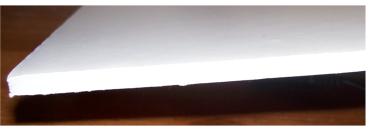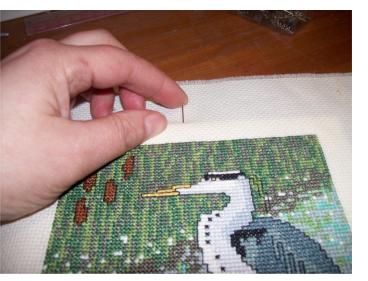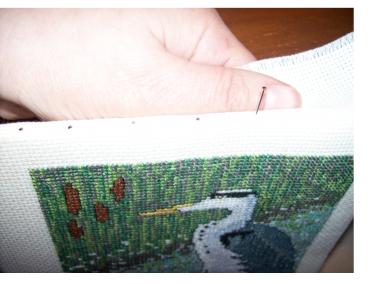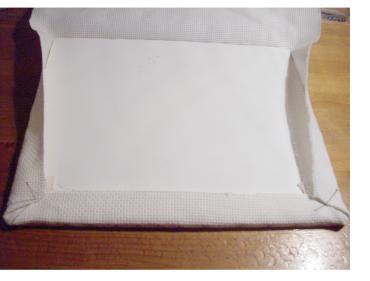- Home
- Cross Stitch
- Framing Cross Stitch
Framing cross stitch yourself: step-by-step
Ever spent hours stitching a beautiful cross-stitch piece, only to let it sit in a drawer because framing is too expensive?
Don't let your hard work go unseen!
In this guide, I'll show you an easy, budget-friendly way to frame your cross-stitch at home—without compromising quality.
What do you need for DIY cross stitch framing?

Your washed and prepared cross stitch piece
Foam core board - provides a sturdy backing
Brass pins - hold fabric in place without damaging it
Craft knife and steel rule - help you cut foam board cleanly
Frame and mat - the mat keeps the glass from touching the fabric
NOTE: Please do not substitute sticky matt board for the foam core. It tends to turn the fabric yellow after time. I learned this to my cost after framing my first few cross stitch projects this way
🧵 Before framing, ensure your fabric is properly prepared.
Read my guide on how to wash and iron cross-stitch before framing..
Choosing a frame for your embroidery
When choosing a frame it may be best to go for something traditional. An up to the minute unusual frame might look good now but could look really dated in years to come.
Think of the room in which the needlework will be hung when choosing the colour of the frame.
If most of the furniture is black, a black frame could fit in well. On the other hand if you love pine furniture then a pine frame may work better.
If you want to add some colour to your framed piece think about using a coloured mount or matt board that compliments the colours used in the picture.
If you have added beads to your cross stitch or are framing a raised embroidery piece you might want to look at frames with a deep rebate.
The rebate is the "lip" on the back where you sit the glass, fabric and mount boards. More room here will allow for a double matt to keep the work away from the glass.
Should you frame cross stitch behind glass?
I guess we all have our own opinions on this subject. I tend not too, as my framed pictures travel around with me to shows, workshops and exhibitions. Glass would make them heavier and may break in transit.
However if your picture is going to be hung on the wall and hardly ever moved, then the points I mentioned above will not be relevant.
If it is going to hang in an area where smokers gather, glass would help protect your valuable work from tobacco smoke.
The important thing is to not let the glass touch the embroidery. One way to do this is to use a mount or matt board. You could also use small pieces of board, just under the frame so they don't show, called spacers.
Using foam core board to mount your work
Wondering what foam core board is? It's simply a layer of foam between two sheets of acid-free card.
You can find it in thick or thin versions, but I suggest going with the thicker one. Just make sure your frame has enough space to fit it, especially if you're adding a mat and glass.

The photo shows the foam core's edges, so you can see how it's made. I've had good results using this foam core board from Amazon and they even offer a black version for dark fabrics.
To fit the foam core board into your frame, cut it slightly smaller than the frame opening. This allows room for the fabric wrapped around it. Use a steel ruler and a sharp craft knife for easy cutting.
1. Position the foam core board

To frame your cross stitch, start by placing your foarm core on a dark surface. This makes it easier to see how much fabric extends beyond the edges.
Lay your cross stitch face up on the board, ensuring an even border on all sides or shift it slightly upwards to leave a bit more space at the bottom.
For this example, I'm using a heron design from my wildlife cross stitch collection.
Secure the fabric by pushing a pin into the foam at the top center, as shown in the photo. Repeat at the bottom, gently pulling the fabric so it fits snugly against the board without bending it. Do the same for the sides, pinning the center of each.
2. Pin the fabric in place

Work your way out from the centre top in both directions. If your cross stitch is on Aida fabric, try to align the rows of squares along the edge of the board to keep everything straight.
Don't worry if it looks a bit off; you can always adjust the pins later.
Next, do the same for the bottom, gently pulling the fabric to keep it smooth against the board.
Repeat this process for the sides until the fabric is pinned on all four sides. Make sure everything is even and the Aida squares are as straight as possible.
3. Dealing with the corners

Once you've secured your cross stitch with pins, it's time to tidy up the corners. Here's how:
- Fold the Corners: Take the fabric at each corner and fold it over the board. Then, fold the sides over the top. Secure each corner with a pin that goes through both the board and foam.
- Stitch the Corners: Use a strong thread to stitch the corners in place. This will keep everything neat and secure.
- Optional Lacing: If you want, you can lace the back of your work. This involves taking long stitches from top to bottom and side to side. However, with this method, leaving the pins in place is usually enough.
By following these steps, you'll have a beautifully mounted cross stitch ready to frame.
4. Finishing the framing
Before you frame your cross stitch, make sure the glass is spotless. This ensures your work shines without any distractions.
Lay the frame face down on your work surface, then carefully place the glass inside.
If you are using a matt or mount board drop that in next, coloured side down.
Add the mounted embroidery and holding the "sandwich" securely tip it over to double check everything is in the right place.
I like to place a piece of acid free paper between the work and the backing board. Then I seal the gaps with framers tape to stop dust or moisture getting in.
Screw fixings into the frame, and attach string on which to hang your work.
Give your cross stitch its forever home
Next time you finish a piece, ask yourself: does this deserve a frame?
Your hard work deserves more than being tucked away.
Stretch it, pin it, and make it look its best. Framing turns your piece into a proud display of your effort.
So, dust off that finished piece sitting in your basket. Grab some foam core, channel your inner picture-framer, and let your needlework finally shine.
🧵 Looking for more creative ways to showcase your needlework?
Stay connected between projects
If you’d like occasional updates from my embroidery room, including new patterns, gentle tips, and little things I think you might enjoy, you’re warmly invited to join the Stitchin’ Times newsletter.
No pressure. Just a friendly note now and then to keep you inspired.